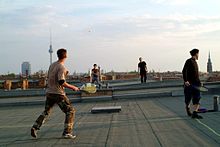
Badminton is a racquet sport played using racquets to hit a shuttlecock across a net. Although it may be played with larger teams, the most common forms of the game are "singles" and "doubles". Badminton is often played as a casual outdoor activity in a yard or on a beach; formal games are played on a rectangular indoor court. Points are scored by striking the shuttlecock with the racquet and landing it within the other team's half of the court.

Tennis is a racket sport that is played either individually against a single opponent (singles) or between two teams of two players each (doubles). Each player uses a tennis racket that is strung with cord to strike a hollow rubber ball covered with felt over or around a net and into the opponent's court. The object of the game is to manoeuvre the ball in such a way that the opponent is not able to play a valid return. The player who is unable to return the ball validly will not gain a point, while the opposite player will.

Table tennis is a racket sport derived from tennis but distinguished by its playing surface being atop a stationary table, rather than the court on which players stand. Either individually or in teams of two, players take alternating turns returning a light, hollow ball over the table's net onto the opposing half of the court using small rackets until they fail to do so, which results in a point for the opponent. Play is fast, requiring quick reaction and constant attention, and is characterized by an emphasis on spin relative to other ball sports, which can heavily affect the ball's trajectory.

Squash, sometimes called squash rackets, is a racket-and-ball sport played by two or four players in a four-walled court with a small, hollow, rubber ball. The players alternate in striking the ball with their rackets onto the playable surfaces of the four walls of the court. The objective of the game is to hit the ball in such a way that the opponent is not able to play a valid return. There are about 20 million people who play squash regularly world-wide in over 185 countries. The governing body of squash, the World Squash Federation (WSF), is recognized by the International Olympic Committee (IOC), and the sport is included in the Olympic Games, after a number of applications. Squash has been added for the 2028 Summer Olympics in Los Angeles. The Professional Squash Association (PSA) organizes the pro tour.
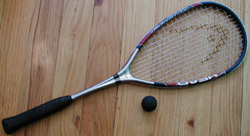
A racket or racquet is a sporting equipment used to strike a ball or shuttlecock back-and-forth in games such as tennis, badminton, squash, racquetball and padel. The typical basic structure of a racket consists of a widened distal end known as the head, an elongated handle known as the grip, and a reinforced connection between the head and handle known as the throat or heart.

Real tennis – one of several games sometimes called "the sport of kings" – is the original racquet sport from which the modern game of tennis is derived. It is also known as court tennis in the United States, royal tennis in England and Australia, and courte-paume in France. Many French real tennis courts are at jeu de paume clubs.

The International Tennis Federation (ITF) is the governing body of world tennis, wheelchair tennis, and beach tennis. It was founded in 1913 as the International Lawn Tennis Federation by twelve national tennis associations. As of 2016, there are 211 national and six regional associations that make up the ITF's membership.

POP tennis is a racket sport adapted from tennis and played for over a century. Compared to tennis, the court is smaller, has no doubles lanes, and the net is lower. Paddle tennis is played with a solid perforated paddle, as opposed to a strung racquet, and a lower pressure tennis ball.

Rackets or racquets is an indoor racket sport played in the United Kingdom, United States, and Canada. It is infrequently called "hard rackets" to distinguish it from the related sport of squash.

Pickleball is a racket or paddle sport in which two players (singles) or four players (doubles) hit a perforated, hollow plastic ball with paddles over a 34-inch-high (0.86 m) net until one side is unable to return the ball or commits a rule infraction. Pickleball is played indoors and outdoors. It was invented in 1965 as a children's backyard game in the United States, on Bainbridge Island in Washington state. In 2022, pickleball was named the official state sport of Washington.
This page is a glossary of tennis terminology.

Ball badminton is a sport native to India. It is a racket sport game, played with a yellow ball made of wool, on a court of fixed dimensions divided by a net. The game was played as early as 1856 by the royal family in Tanjore, the capital of Thanjavur district in Tamil Nadu, India. It enjoys the greatest popularity in India. Ball badminton is a fast-paced game; it demands skill, quick reflexes, good judgment, agility, and the ability to control the ball with one's wrist.
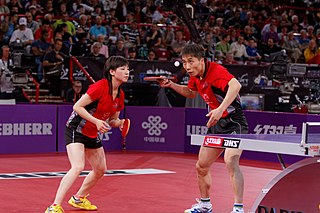
Mixed doubles or mixed pairs is a form of mixed-sex sports that consists of teams of one man and one woman. This variation of competition is prominent in curling and racket sports, such as tennis, table tennis, and badminton, as well as gymnastics, figure skating, and card games such as contract bridge.
Several sports related to volleyball have become popular. Indoor volleyball and beach volleyball are both events at the Olympics, and sitting volleyball is an event at the Paralympics. Other varieties are localized, or are played at an amateur or informal level.

Racketlon is a combination sport in which competitors play a sequence of the four most popular racket sports: table tennis, badminton, squash, and tennis. It originated in Finland and Sweden and was modeled on other combination sports like the triathlon and decathlon.
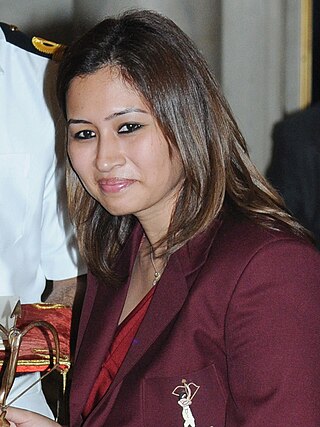
Jwala Gutta is an Indian badminton player. Beginning in the late 1990s, she represented India at international events in both mixed and women's doubles. She has a total of 316 match wins in both the disciplines—the most by any Indian—and peaked at no. 6 in the world rankings. Gutta has won medals at numerous tournaments on the BWF circuit including a silver at the 2009 Superseries Masters Finals and a bronze at the 2011 World Championships.

Squash Doubles is a variant of the racket sport squash played by four people in two-person teams. Doubles squash was first played at the Racquet Club of Philadelphia in 1907. Today there are four major doubles organizations overseeing the sport in North America and more than 15,000 players: Squash Canada, U.S. Squash, the ISDA and the WDSA. The four groups organize and oversee the management of all aspects of doubles including junior and adult play from beginner to elite professional competition. In addition, the four organizations collaborate in efforts to grow and promote the game.
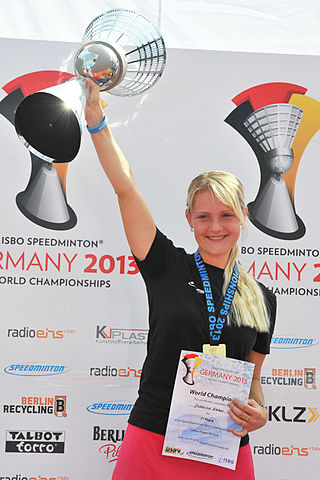
Jasmina Keber is a triple World Champion and double European Champion crossminton player from Slovenia.

The 2013 ICO Crossminton World Championships was a crossminton tournament, taking place in Berlin, Germany, between 13 and 15 June 2013. With the 1st Crossminton World Championships being played in 2011 and the competition taking place every two years, the 2013 World Championships was the 2nd ICO Crossminton World Championships ever being played. 479 players from 29 countries participated at the event that took place at a time when crossminton was still named speed badminton.
The 2011 ICO Crossminton World Championships, with the full name 1. ISBO Azimut Hotels Speedminton® World Championships, was a crossminton tournament, taking place in Berlin, Germany, a between 24 and 25 August 2011. It was the 1st ever Crossminton World Championships to be played and 370 players from 29 countries participated at the event that took place at a time when crossminton was still named speed badminton.

